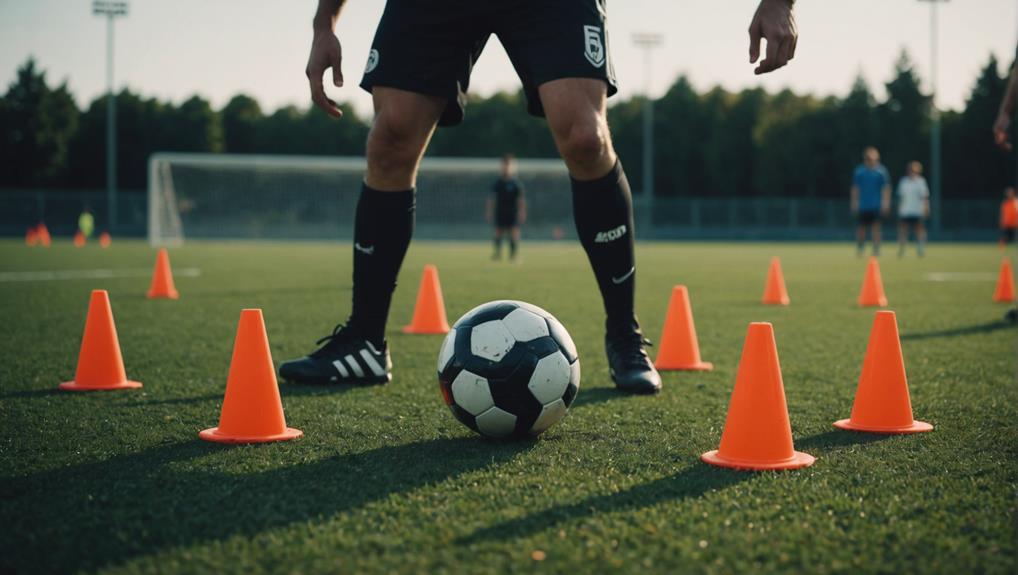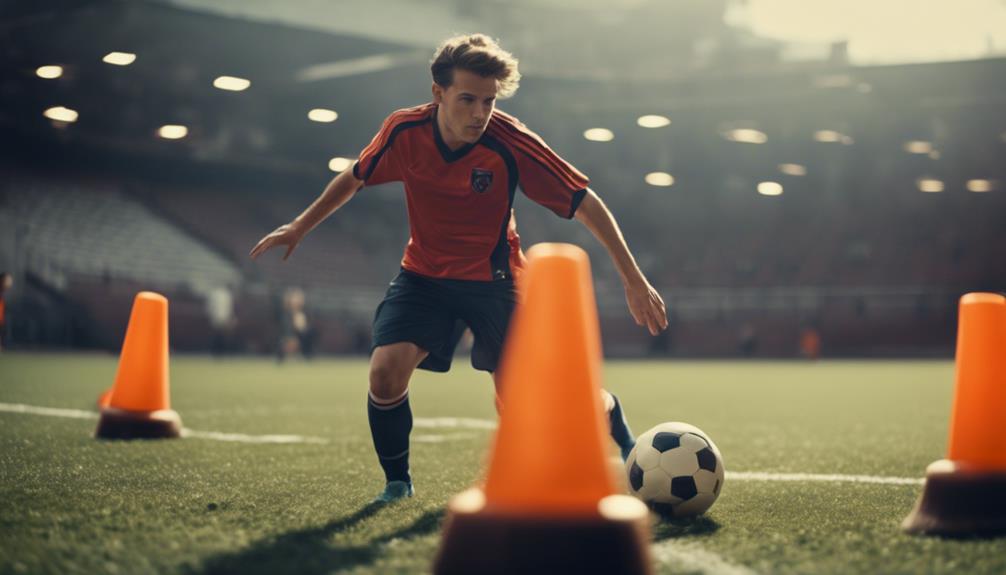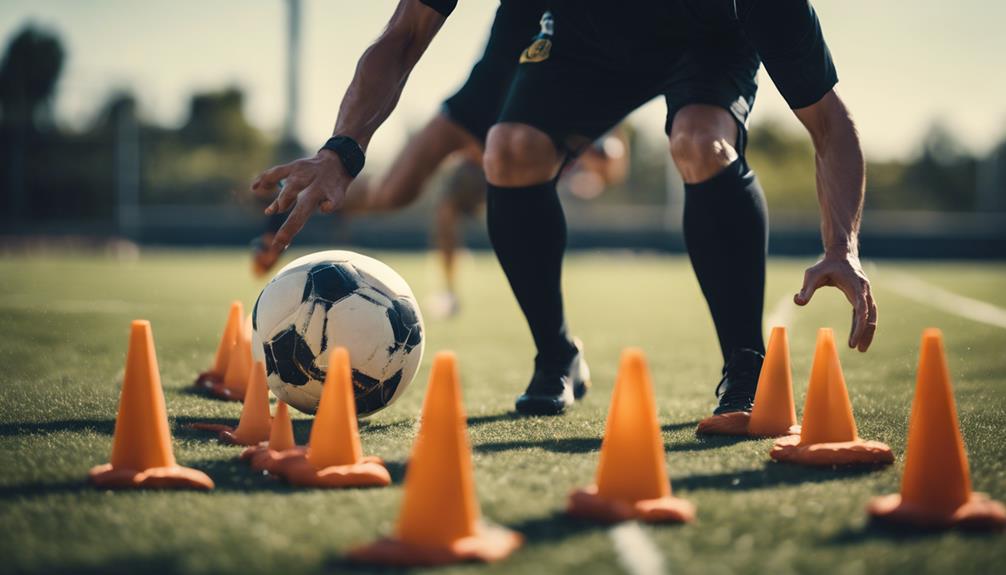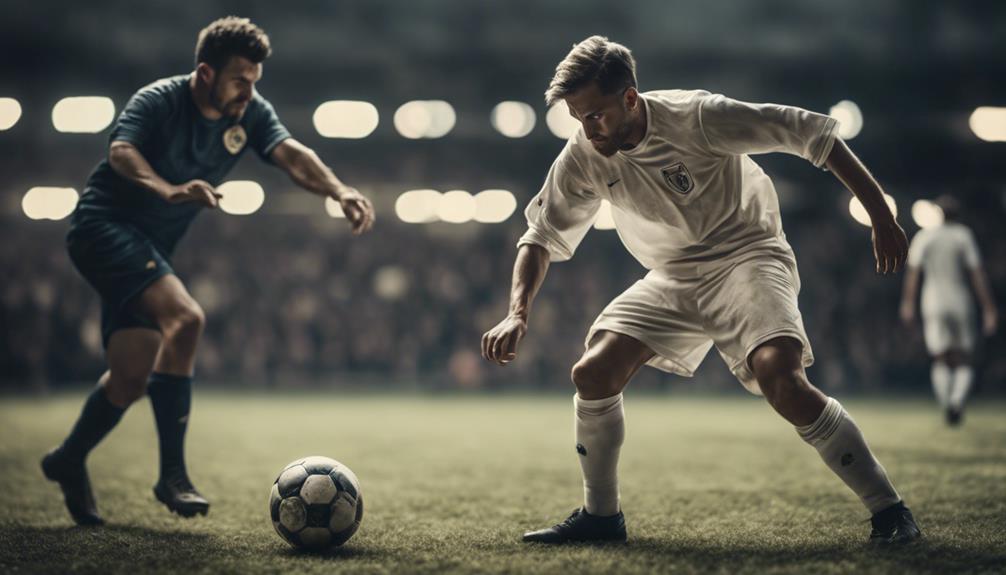
Building a Strong Soccer Defence: Tips and Drills
July 29, 2024To strengthen your soccer defense, focus on pressure, cover, and balance as foundational aspects of a solid backline. Prioritize immediate pressure on the ball, supported by coordinated cover to maintain defensive shape. Enhance defensive skills through dynamic drills and small-sided games, which simulate real-game scenarios and boost strategic acumen. Emphasize principles like delay, compactness, and ensuring proper spacing between defenders for effective coverage. Incorporate 1v1 defensive drills to sharpen individual skills such as body positioning and timing of tackles. Utilize specific pressing techniques to disrupt opponents, and work on mental toughness for improved decision-making under pressure. You're on the right track!
Coaching Defense Ingredients
To coach defense effectively, you must prioritize pressure, cover, and balance as essential elements. When it comes to maintaining a solid defensive shape, immediate pressure on the ball is key. Guaranteeing that the closest player to the ball applies pressure helps disrupt the opponent's attack and buy time for the rest of the team to adjust their positions. This pressure also prevents the attacker from having time to make decisions comfortably, increasing the chances of winning the ball back.
In coaching defense, cover plays a vital role in supporting the player applying pressure. Covering positions allow teammates to anticipate potential passes or runs, providing a safety net if the initial pressure is bypassed. Emphasizing the coordination between pressure and cover helps in creating a cohesive defensive unit that can effectively thwart the opponent's advances.
Moreover, maintaining balance in defensive play is crucial for a well-rounded defense. Balancing defensive responsibilities ensures that the team isn't vulnerable to quick counterattacks or positional overloads. By understanding and implementing these principles of defending, you can lay a strong foundation for your team's defensive capabilities.
Small-Sided Games for Defense
Small-sided games are a powerhouse for boosting your defensive skills. You'll be immersed in scenarios that demand quick thinking, improving your grasp of essential defensive principles.
Get ready to elevate your game through dynamic drills that enhance your strategic acumen.
Game-Based Defensive Training
Enhance your defensive skills through game-based training drills that simulate real game scenarios and promote quick decision-making.
Small-sided games for defense offer an effective way to work on your defensive abilities in a dynamic and engaging environment. These training drills focus on honing your defensive techniques, such as pressuring the ball, covering teammates, and maintaining defensive shape.
By participating in game-based defensive training, you'll develop a better understanding of how to react swiftly to different defensive situations. These drills encourage effective communication among teammates, helping you coordinate your defensive efforts efficiently.
Additionally, small-sided games teach you how to seamlessly shift between offensive and defensive roles, preparing you for the fluid nature of real matches.
Defensive Strategy Development
Players in small-sided games for defense gain valuable experience in developing strategic defensive skills through simulated match scenarios. These drills are essential to teach players the intricacies of defensive tactics effectively.
Here's how these defensive soccer drills can benefit you:
- Understanding Defensive Strategies: Small-sided games help you grasp the various defensive strategies and when to apply them during a match.
- Enhancing Decision-making Skills: By participating in these drills, you can improve your ability to make quick and effective decisions in defensive situations.
- Improving Communication: Working with your teammates in these games will enhance your communication skills, vital for maintaining a strong defensive line.
- Mastering Defensive Principles: Through these drills, you'll learn the importance of pressing, delaying, and maintaining compactness, key elements in building a solid defense.
Engage in these small-sided games to sharpen your defensive skills and become a more effective defender on the field.
Defensive Soccer Drills for Skills

To hone your defensive skills in soccer, engaging in structured drills that emphasize marking, tackling, and positioning is vital. Defensive soccer drills play an important role in enhancing the coordination and effectiveness of both individual defenders and the defensive unit as a whole. By focusing on these key skills, players can improve their decision-making under pressure, reaction time to intercept passes, and overall defensive awareness on the field.
Practicing defensive drills not only benefits individual defenders but also contributes to the cohesion and communication within the defensive unit. These drills lay the foundation for a solid defensive strategy during matches, allowing players to anticipate opposition movements and react swiftly to regain possession.
Regularly incorporating defensive drills into training sessions is key to boosting defensive performance and ensuring that the team is well-prepared to thwart opponents' attacks effectively. Strengthening defensive skills through targeted drills ultimately leads to a more robust and reliable defensive line during games.
Principles of Defending
Understanding and implementing the principles of defending are essential for a solid defensive strategy in soccer. By following these principles, defenders can work together effectively to maintain a strong defensive shape and make collective decisions on the field.
Here are four key principles that can enhance your team's defensive capabilities:
- Delay: Slow down the opposition's attack by applying pressure and compelling them to make decisions quickly.
- Compactness: Stay organized as a defensive unit to limit space and passing lanes for the opponents.
- Depth: Guarantee there's proper spacing between defenders to cover different areas of the field effectively.
- Balance: Coordinate movements to guarantee there are no gaps in defense and cover each other when necessary.
1v1 Defensive Drills

Mastering 1v1 defensive drills is vital for enhancing individual defending skills in soccer. These drills focus on improving a player's ability to win duels and protect the goal effectively. By practicing 1v1 scenarios, players develop essential skills such as proper body positioning, the timing of tackles, and making quick decisions under pressure. The emphasis on these aspects helps players gain confidence and composure when facing offensive threats.
During 1v1 defensive drills, players learn how to anticipate their opponent's movements, stay goal-side, and challenge effectively to win the ball. These drills create a competitive environment that simulates real-game situations, allowing players to sharpen their defensive techniques. Regular practice of 1v1 drills translates into improved overall defensive performance on the field.
2v2 Defensive Drills
Improve your defensive skills with 2v2 drills, emphasizing quick switches between defense and attack. These drills are essential for players looking to enhance their defensive capabilities by focusing on rapid shifts and immediate pressure on the ball.
Here are some key points to keep in mind when incorporating 2v2 defensive drills into your training regimen:
- Apply Immediate Pressure: Practice closing down opponents swiftly to limit their time on the ball and force mistakes.
- Effective Covering Techniques: Learn how to provide support to your teammate in defense by covering spaces and players efficiently.
- Enhance Defensive Shape: Work on maintaining a solid defensive shape with your partner to limit the opponent's attacking options.
- Read and Anticipate: Develop the ability to read the play and anticipate your opponents' movements to stay one step ahead in defense.
Pressing Techniques in Defense

To build a solid defense in soccer, it's essential to understand pressing triggers and how to identify them during gameplay. Effective pressing hinges on your team's ability to coordinate movements and apply pressure as a cohesive unit.
Pressing Triggers Identification
Identifying pressing triggers is vital for executing effective defensive pressing in soccer. When your team can recognize these cues, you increase the chances of winning the ball back and disrupting the opponent's flow.
Here are some key points to keep in mind:
- Specific Cues: Pressing triggers can vary but often include a bad touch by an opponent, a back pass towards their own goal, or a player turning into pressure.
- Quick Reaction: Being able to react swiftly to these triggers is important for a successful pressing strategy. Anticipation and readiness are key.
- Disruption and Turnovers: By capitalizing on pressing triggers, your team can disrupt the opponent's attack, regain possession, and create scoring opportunities.
- Training and Preparation: Coaches play a crucial role in training players to anticipate pressing triggers through drills and tactical sessions. Regular practice enhances your team's defensive capacities and overall performance.
Team Coordination Strategies
Enhancing team coordination is essential in mastering effective pressing techniques in soccer defense. Pressing requires synchronized movements and a shared understanding among players to disrupt the opponent's build-up play.
One key aspect of team coordination is the angle of approach when pressing. By angling your body towards the opponent's weak side or a specific direction, you can limit their passing options and force them into making errors.
To improve team coordination, consider utilizing a 7v7 format in training sessions. This smaller game size allows players to focus on the fundamentals of pressing collectively. As you progress, advance to a 9v9 setup to practice more complex defensive strategies as a team.
Understanding pressing triggers and working together to apply pressure quickly can prevent conceding goals from lobbed long balls.
For more guidance on team coordination strategies and pressing techniques, feel free to Contact Us for personalized advice tailored to your team's needs.
Building Mental Toughness in Defense
Developing mental toughness in defense is important for soccer players to excel under pressure and make quick, effective decisions to thwart opponents. To strengthen your mental resilience on the field, consider the following tips:
- Stay Focused: Maintain your concentration during the entire game, especially when the opposition is pressing.
- Quick Decision-Making: Train yourself to react swiftly when playing the ball and anticipate your opponent's moves.
- Visualization Techniques: Practice mentally rehearsing different defensive scenarios to enhance your performance during matches.
- Positive Mindset: Cultivate a mindset of self-discipline and optimism to bounce back from setbacks and challenges.
Conclusion
So there you have it, all the tools you need to build a rock-solid defense for your soccer team.
Remember, Rome wasn't built in a day, so don't expect your defense to be perfect overnight.
Practice makes perfect, so keep working on those defensive drills and principles.
Before you know it, your defense will be as strong as an ox and your opponents won't stand a chance!
Keep pushing, keep improving, and keep dominating on the field.


